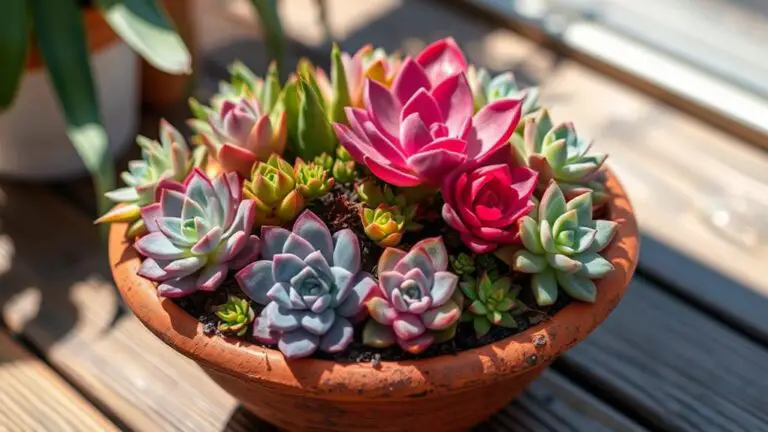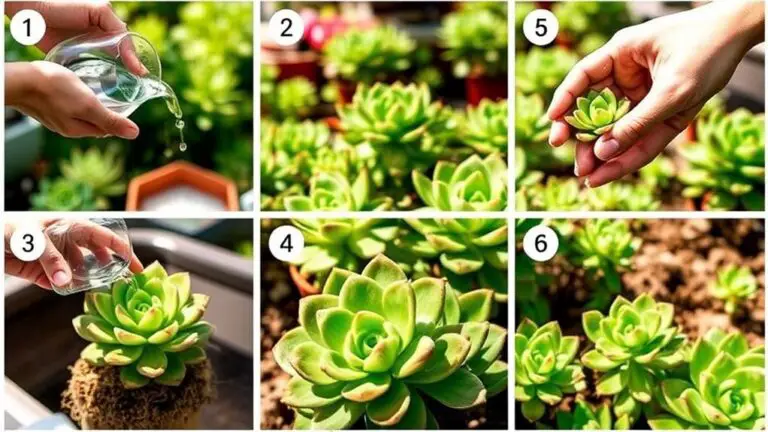10 Easy Ways to Identify Your Succulents
Identifying your succulents doesn't have to be an intimidating task. You can start by observing the leaf shape, which often provides significant clues. Are the leaves thick or thin, spiky or rounded? Don't forget to note the color variations, as they can change with the seasons. Another useful method is to pay attention to the flower characteristics; their shape and color can be quite telling. Technology can also be your friend here, with plant ID apps offering quick insights. Wondering how to keep track of all this? There's a simple way to organize your findings that will make the identification process much easier.
Observe Leaf Shape
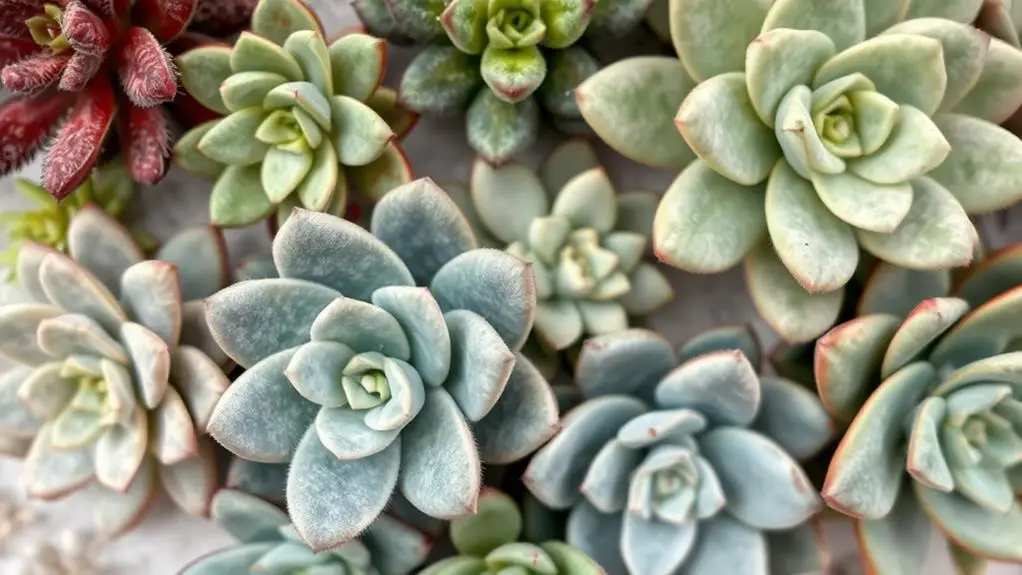
When identifying succulents, one of the first things you should do is observe the leaf shape. Leaf shape is a key distinguishing feature that can help you tell different succulents apart. Common forms include rosettes, chubby leaves, and elongated shapes.
For example, Echeveria typically has spoon-shaped leaves that form a beautiful rosette. On the other hand, Pachyphytum features chubby, elongated leaves that create a unique silhouette.
Take a close look at the leaf margins, too. Some succulents like Kalanchoe have serrated or fuzzy edges, while others, such as Crassula, exhibit smooth, rounded margins. These details can be very helpful in narrowing down your plant's identity.
Another tip is to examine how the leaves are arranged on the stem. Are they opposite each other, alternating, or clustered together? Each arrangement can be a clue to the type of succulent you have.
Examine Leaf Color
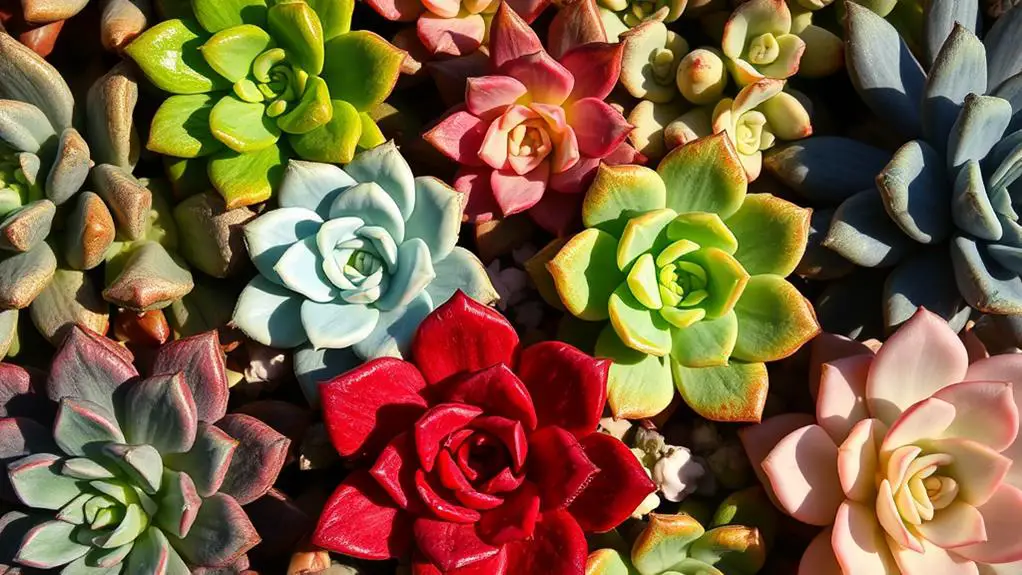
When you examine the leaf color of succulents, you'll notice a wide range of hues, from deep greens to vibrant purples or reds.
These colors often change with the seasons or under different conditions like strong sunlight, which can make succulents like Echeveria display brighter colors.
Pay attention to these color patterns and seasonal changes, as they can help you identify and care for your succulents better.
Color Patterns and Hues
Succulent leaves come in a dazzling array of colors, providing key clues for identification. You'll notice a wide range of hues from greens and blues to purples and reds. These color patterns can help you narrow down the type of succulent you have.
For instance, Echeveria species often display vibrant hues, especially when exposed to more sunlight or during times of drought.
Some succulents, like Sedum, have variegated leaves with cream or yellow margins, adding another layer for you to evaluate. These color patterns aren't just beautiful; they're also useful for identifying your plants.
Additionally, you might spot a powdery coating, known as farina, on types like Echeveria and Cotyledon. This coating can make the leaves appear more muted or grayish, which is another helpful clue.
Seasonal Color Changes
Experiencing vibrant seasonal color changes, many succulents transform dramatically with shifts in light and temperature.
These changes can be striking and very useful for identifying your plants. When succulents are exposed to varying light conditions, their leaf colors can enhance, making them easier to distinguish.
For instance, Echeveria species often display more vivid colors like red or purple when stressed by intense sunlight or drought.
Factors such as temperature fluctuations, sunlight exposure, and water availability play significant roles in these seasonal color changes.
Here's what to look for:
- Red, purple, or orange hues: These colors often indicate your succulent is experiencing stress from sunlight or drought.
- Yellowing leaves: This can be a sign of overwatering.
- Dull, faded colors: Typically suggest your plant isn't getting enough light.
- Vivid colors in Echeveria: Especially noticeable during intense sunlight or drought periods.
- Characteristic color ranges: Different species show more pronounced colors during specific seasons, aiding in identification.
Observing these seasonal color changes won't only help you identify your succulents more accurately but also guarantee they're healthy and thriving.
Keep an eye out for these signs and enjoy the vibrant transformations!
Check Growth Patterns
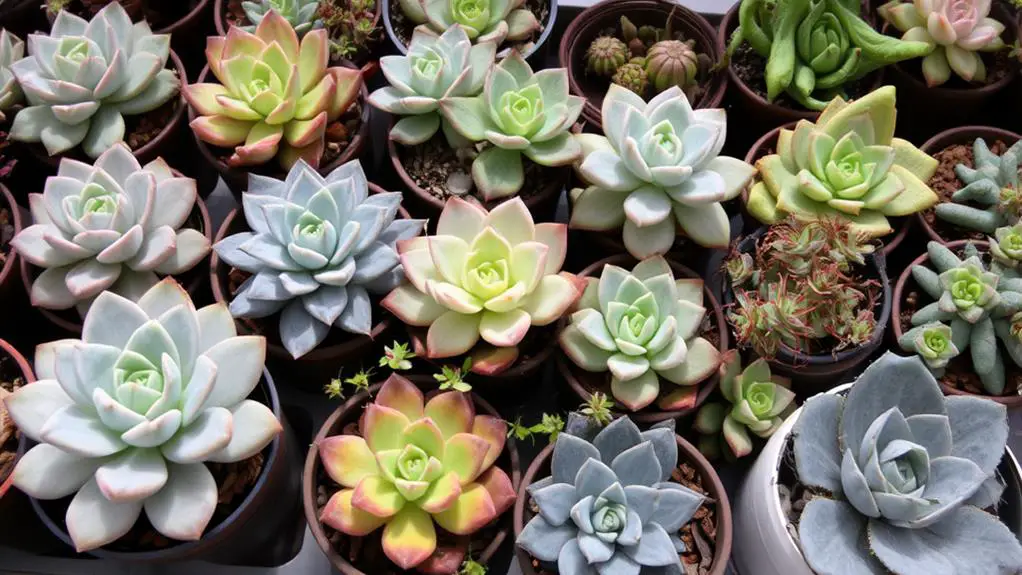
Understanding the growth patterns of succulents is essential for accurate identification and ideal care. When you're trying to identify your succulent, start by observing its growth pattern. Does it grow in a rosette shape, like Echeveria and Sempervivum, or does it have an upright form, such as Agave and Euphorbia? These distinct shapes can help you narrow down the type of succulent you have.
Next, look at the leaf arrangement. Some succulents, like Sedum, have a trailing habit, while others, such as Haworthia, grow in compact clusters. This can give you clues about their identification and needs. Also, check if your succulent produces offsets or "pups." Varieties like Sempervivum and Aloe often do this, indicating healthy growth.
Consider the growth rate too. Fast-growing succulents like Sedum suggest you're providing ideal conditions. Slower-growing types, like certain Echeveria, might need a bit more attention.
Here's a handy table to summarize these growth patterns:
| Succulent Type | Growth Pattern | Example Varieties |
|---|---|---|
| Rosette Growth | Circular clusters | Echeveria, Sempervivum |
| Upright Growth | Vertical growth | Agave, Euphorbia |
| Trailing Growth | Spreading stems | Sedum |
| Compact Clusters | Dense groupings | Haworthia |
Note Flower Characteristics
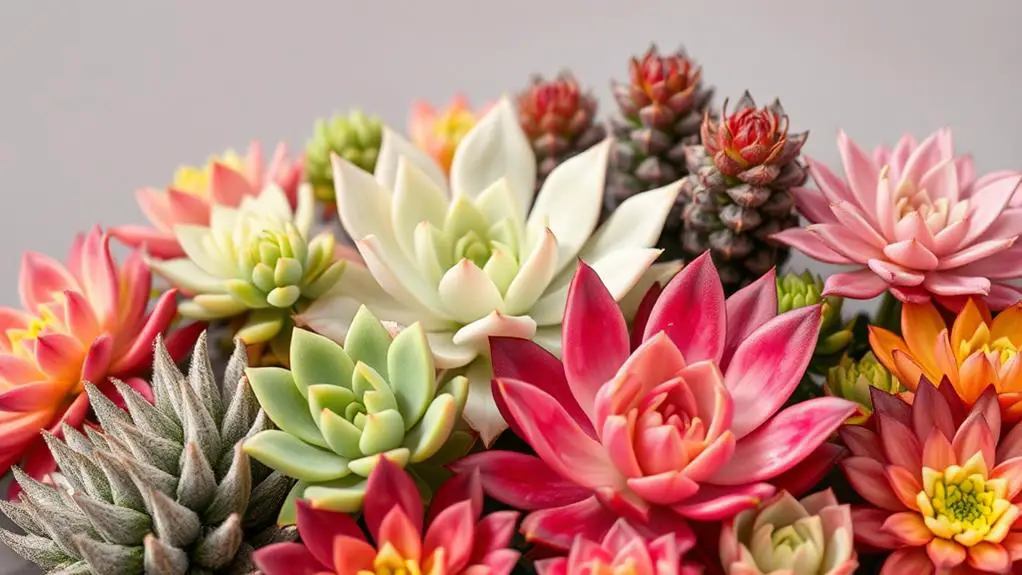
When identifying succulents, noting their flower characteristics can be incredibly helpful. Succulents often have unique blooms that make them easier to distinguish. To get started, pay attention to the shape, color, and size of the flowers.
For instance, Echeveria flowers are typically tubular and come in vibrant colors like red, orange, or yellow. On the other hand, Sempervivum flowers have star-like blooms that rise on tall stalks.
To make things easier, here are some key flower characteristics to observe:
- Shape: Look for tubular, star-like, or clustered blooms.
- Color: Note the vibrant hues which can range from red and orange to yellow.
- Size: Observe if the flowers are large and showy or small and delicate.
- Timing: Pay attention to when the succulent blooms; some only flower in spring or summer.
- Arrangement: Check if the flowers grow on long stems, in dense clusters, or on tall stalks.
Use Plant ID Apps
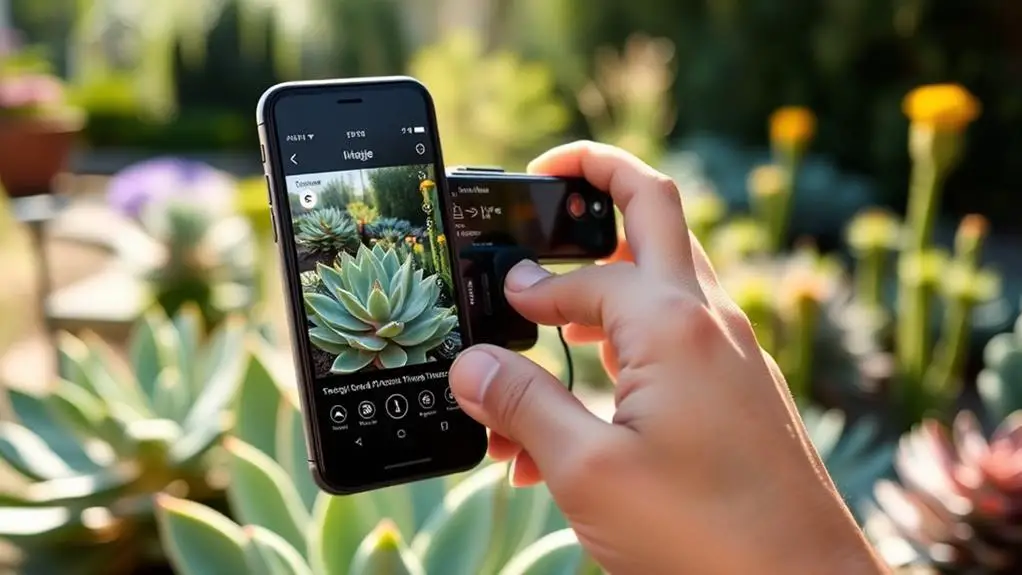
While noting flower characteristics is invaluable, technology offers another powerful tool for identifying succulents: plant ID apps. These apps are incredibly user-friendly and can save you a lot of time. For example, Pl@ntNet and iNaturalist let you upload clear photos of your succulents. The app then analyzes these images to suggest possible species and even offers plant care recommendations.
If you're focused specifically on succulents, the Drought Smart Plants' Succulent ID app is a fantastic choice. It allows detailed searches based on visual characteristics, making it easier to identify various succulent species.
Google Lens is another handy tool. Just snap a photo of your succulent, and you'll instantly get information about the plant, including potential species and plant care tips.
Many of these apps also have community features. This means you can get feedback and identification help from fellow plant lovers and experts.
Plus, they often come with extensive databases filled with images and descriptions of thousands of succulent species. This makes finding accurate matches a breeze. By using these apps, you'll feel more confident in your ability to care for and identify your succulents.
Join Online Communities
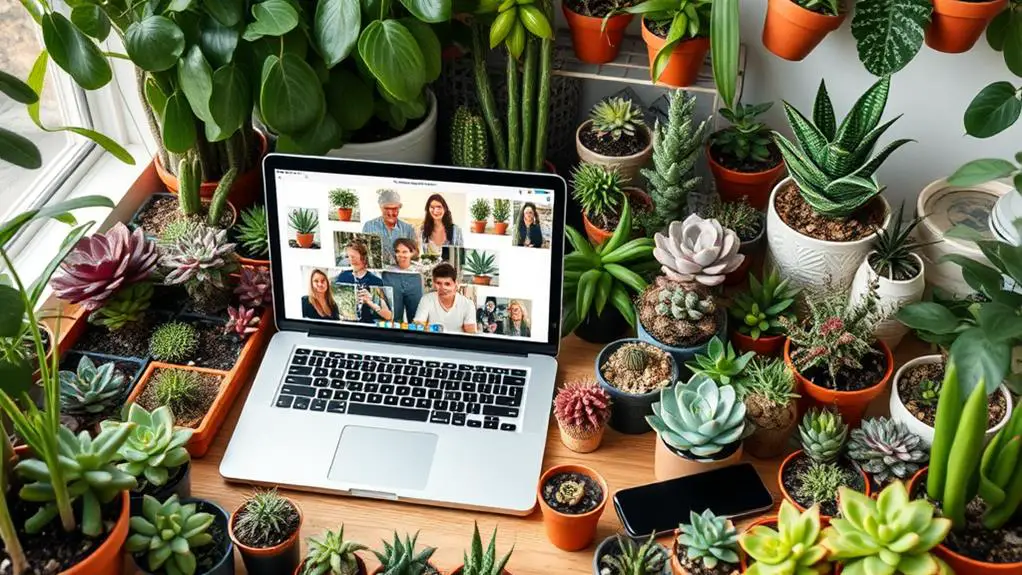
Joining online communities is an excellent way to deepen your knowledge and get real-time support for succulent identification. When you join online communities, you connect with fellow enthusiasts who share your passion for these unique plants. These groups are treasure troves of information and support.
To get started, consider these options:
- Social Media Groups: Join succulent-related groups on platforms like Facebook or Instagram. Here, you can post pictures and ask for help with identifying your plants.
- Succulent Lovers Club: This is a great place to share photos and receive feedback from experienced members who know a lot about succulent care.
- Online Forums: Participate in forums dedicated to succulent care. Members often share their experiences and tips for identifying different species.
- Plant Identification Apps: Some apps allow you to upload photos and connect with experts who can give you insights into your succulents.
- Follow Hashtags: Use hashtags like #SucculentIdentification on social media to discover various species and see how others identify their plants.
Engaging with these communities helps you learn faster and makes caring for your succulents more enjoyable. You'll find that people are usually very supportive and enthusiastic to share their knowledge.
Compare With Databases

Using databases to compare your succulents is a powerful way to identify them accurately. These databases contain over 17,000 different species, making it easier to match your plant's visual characteristics. You can filter succulents based on specific traits like leaf shape, color, and growth patterns. This makes the identification process smooth and precise.
A great feature of these databases is the option to upload photos of your succulents. By doing this, you can get help from experts or community members who can provide valuable insights. Websites like the Types of Succulents page and The Succulent Plant Page Gallery are excellent resources. They offer updated images and care information, ensuring you have the latest details at your fingertips.
To make things even easier, you can use Google Search to compare your succulent with images found in these databases. This can help you narrow down the genus and species effectively. Here's a handy table to guide you:
| Database Feature | Description | Benefit |
|---|---|---|
| Visual Characteristics | Search by leaf shape, color, growth patterns | Precise matching |
| Photo Upload | Get assistance from experts or community | Accurate identification |
| Types of Succulents | Updated images and care info | Reliable resources |
| Succulent Plant Gallery | Extensive image collection | Easy comparison |
| Google Search | Compare images to narrow down species | Effective identification |
Using these tools, you're well on your way to becoming a succulent identification pro!
Consult Gardening Experts
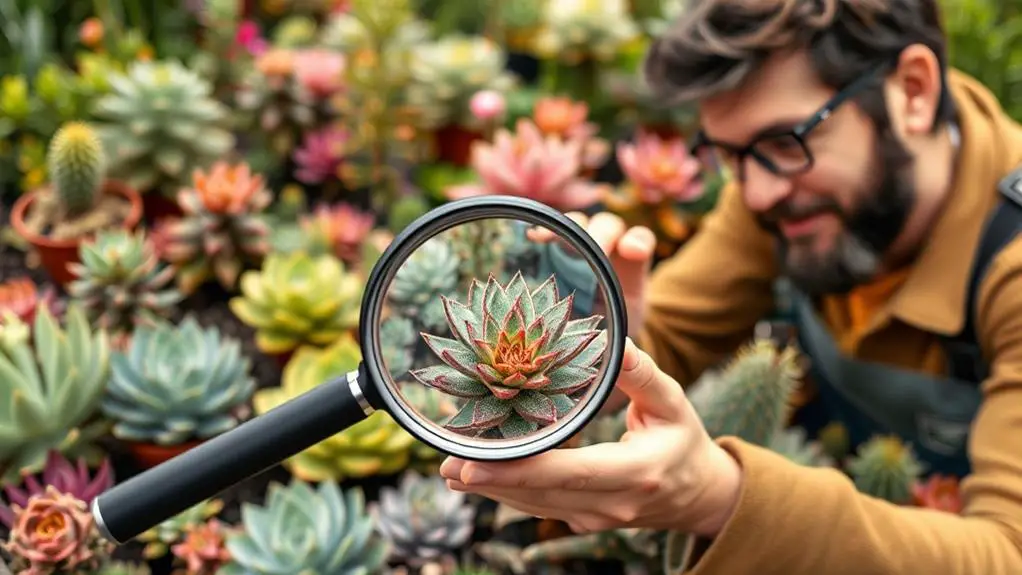
Engaging with gardening experts can greatly enhance your succulent identification skills. Their firsthand experience with various species' characteristics and care needs can be invaluable. By consulting gardening experts, you can gain insights that are difficult to find elsewhere.
Here are some ways to connect with these knowledgeable individuals:
- Online Forums: Many gardening experts participate in forums and social media groups, providing quick access to advice and identification support.
- Local Gardening Centers: Visiting local centers or plant nurseries can put you in direct contact with experts who offer immediate feedback on your succulents.
- Plant Identification Apps: These apps often have expert consultation options, allowing you to upload photos of your plants and receive professional input.
- Workshops and Events: Attending local gardening workshops can help you meet experts who can assist in both identifying and caring for your succulents.
- Professional Gardeners: Hiring a professional gardener for a consultation can provide personalized advice tailored to your specific succulent collection.
Verify With Google Images

To effectively identify your succulent, a Google image search can be a powerful tool. Start by taking a clear photo of your plant. Make sure the image is well-lit and focused.
Then, upload this photo to Google using the "Search by Image" feature. This will help you find visually similar plants and potential matches for identification.
Refine your search by adding descriptive keywords. If your succulent has unique features like fuzzy leaves, spiky edges, or a distinct color, include those terms. For example, you might type "fuzzy succulent" or "red spiky succulent." This will help you narrow down the genus and species by comparing your plant's characteristics with those in the search results.
Explore related images and suggestions that Google presents. These can provide more details about your identified succulent, including care requirements.
Bookmark or save the images of succulents that closely match yours. This will be useful for future reference and ongoing plant care.
Using Google Images not only helps you identify succulents but also makes it easier when you want to buy succulents. Armed with the right information, you'll be more confident in your gardening journey.
Document Your Findings
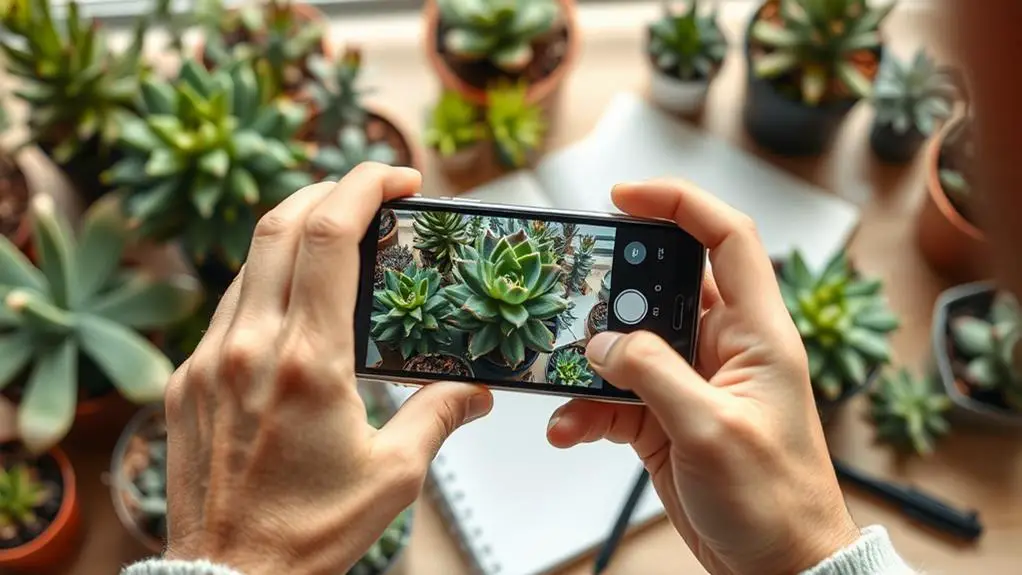
Start by using clear pot labels to track each succulent species easily.
Regularly take photos of your succulents to document their growth stages and observe changes over time.
This way, you can create a detailed record and have a visual reference to help with identification and care.
Utilize Clear Pot Labels
When dealing with a diverse collection of succulents, clear pot labels become invaluable tools for organization and care.
These labels help you keep track of essential information like the succulent's name, species, and specific care requirements. This makes it much easier to guarantee each plant gets the right amount of attention and care it needs to thrive.
Using clear pot labels, you can:
- Identify Succulent Types: Write down the name and species of each succulent.
- Track Care Requirements: Note down specific care instructions like watering frequency and light needs.
- Monitor Growth: Include the date of acquisition or repotting to see how your plants grow over time.
- Color-Code: Use different colors to easily differentiate between types of succulents.
- Guarantee Legibility: Use waterproof markers so the information stays readable even with exposure to water and sunlight.
Regularly update these labels as you learn more about each succulent or make changes to their care routine.
This helps you stay organized and informed. Remember, clear pot labels not only make your gardening experience smoother but also guarantee your succulents get the best possible care.
Keep your collection thriving and beautiful!
Regularly Photograph Growth Stages
Photographing your succulents regularly is an essential practice for tracking their growth and identifying species-specific traits. By taking photos at different stages, you can observe how they change and develop over time.
To make sure your photos are helpful, use consistent lighting and backgrounds. This will help you clearly see differences and similarities as your plants grow.
Capture close-up images of leaf shapes, colors, and patterns. These details are often key to identifying your succulents accurately. Additionally, don't forget to document flowering periods. Many succulents have unique flowers, and these can provide important clues for species identification.
Keeping a photographic log is also very useful. Note the dates and any observations about your plants' growth habits.
This can help you understand how different factors, like sunlight and watering, affect each succulent. Over time, you'll build a valuable resource that will make it easier to identify your plants and care for them properly.
Frequently Asked Questions
How Do I Figure Out What Kind of Succulent I Have?
Take a clear, well-lit photo of your succulent. Use apps like Google Lens or Pl@ntNet to analyze it. Share pics on social media groups for help. Compare traits to images on specialized websites to identify your plant.
What Is the Best Free Succulent Identifier App?
You can use Pl@ntNet for its vast database or iNaturalist for community support. Google Lens is great for quick IDs. For detailed care tips, try Drought Smart Plants' Succulent ID app. All are free and effective.
How Do I Identify an Indoor Succulent Plant?
To identify an indoor succulent, examine the leaf shape, color, and texture. Check the growth habit and flowering characteristics. Use plant identification apps or online communities by sharing clear photos to get accurate assistance.
How to Tell if a Plant Is a Succulent?
You can tell if a plant is a succulent by checking for thick, fleshy leaves or stems that store water. Look for unique shapes, colors, and textures, and make certain it thrives in well-draining soil and dry conditions.
Conclusion
By using these 10 easy methods, you'll become a pro at identifying your succulents in no time. Take your time to observe their unique features, use technology to your advantage, and don't hesitate to ask for help from experts. Documenting your findings will help you track your plants' growth and care needs. Remember, gardening is a journey, and each step you take brings you closer to understanding and enjoying your succulent collection even more. Happy gardening!


